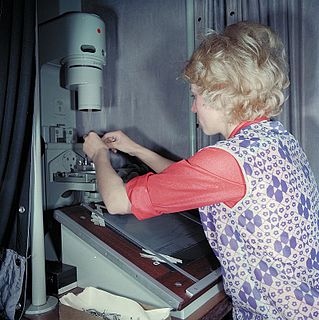
Quality control (QC) is a process by which entities review the quality of all factors involved in production. ISO 9000 defines quality control as "A part of quality management focused on fulfilling quality requirements".
Six Sigma (6σ) is a set of techniques and tools for process improvement. It was introduced by American engineer Bill Smith while working at Motorola in 1986. A six sigma process is one in which 99.99966% of all opportunities to produce some feature of a part are statistically expected to be free of defects.
Quality assurance (QA) is a way of preventing mistakes and defects in manufactured products and avoiding problems when delivering products or services to customers; which ISO 9000 defines as "part of quality management focused on providing confidence that quality requirements will be fulfilled". This defect prevention in quality assurance differs subtly from defect detection and rejection in quality control and has been referred to as a shift left since it focuses on quality earlier in the process.
A business process, business method or business function is a collection of related, structured activities or tasks by people or equipment in which a specific sequence produces a service or product for a particular customer or customers. Business processes occur at all organizational levels and may or may not be visible to the customers. A business process may often be visualized (modeled) as a flowchart of a sequence of activities with interleaving decision points or as a process matrix of a sequence of activities with relevance rules based on data in the process. The benefits of using business processes include improved customer satisfaction and improved agility for reacting to rapid market change. Process-oriented organizations break down the barriers of structural departments and try to avoid functional silos.
In product development and process optimization, a requirement is a singular documented physical or functional need that a particular design, product or process aims to satisfy. It is commonly used in a formal sense in engineering design, including for example in systems engineering, software engineering, or enterprise engineering. It is a broad concept that could speak to any necessary function, attribute, capability, characteristic, or quality of a system for it to have value and utility to a customer, organization, internal user, or other stakeholder. Requirements can come with different levels of specificity; for example, a requirement specification or requirement "spec" refers to an explicit, highly objective/clear requirement to be satisfied by a material, design, product, or service.
Design for Six Sigma (DFSS) is an Engineering design process, business process management method related to traditional Six Sigma. It is used in many industries, like finance, marketing, basic engineering, process industries, waste management, and electronics. It is based on the use of statistical tools like linear regression and enables empirical research similar to that performed in other fields, such as social science. While the tools and order used in Six Sigma require a process to be in place and functioning, DFSS has the objective of determining the needs of customers and the business, and driving those needs into the product solution so created. It is used for product or process design in contrast with process improvement. Measurement is the most important part of most Six Sigma or DFSS tools, but whereas in Six Sigma measurements are made from an existing process, DFSS focuses on gaining a deep insight into customer needs and using these to inform every design decision and trade-off.
In the context of software engineering, software quality refers to two related but distinct notions:
Quality management ensures that an organization, product or service is consistent. It has four main components: quality planning, quality assurance, quality control and quality improvement. Quality management is focused not only on product and service quality, but also on the means to achieve it. Quality management, therefore, uses quality assurance and control of processes as well as products to achieve more consistent quality. Quality control is also part of Quality Management. What a customer wants and is willing to pay for it, determines quality. It is a written or unwritten commitment to a known or unknown consumer in the market. Thus, quality can be defined as fitness for intended use or, in other words, how well the product performs its intended function.

Operations management is an area of management concerned with designing and controlling the process of production and redesigning business operations in the production of goods or services. It involves the responsibility of ensuring that business operations are efficient in terms of using as few resources as needed and effective in meeting customer requirements.
Quality, cost, delivery (QCD), sometimes expanded to quality, cost, delivery, morale, safety (QCDMS), is a management approach originally developed by the British automotive industry. QCD assess different components of the production process and provides feedback in the form of facts and figures that help managers make logical decisions. By using the gathered data, it is easier for organizations to prioritize their future goals. QCD helps break down processes to organize and prioritize efforts before they grow overwhelming.
Advanced product quality planning (APQP) is a framework of procedures and techniques used to develop products in industry, particularly in the automotive industry. It differs from Design For Six Sigma in that the goal of DFSS is to reduce variation.
A process is a unique combination of tools, materials, methods, and people engaged in producing a measurable output; for example a manufacturing line for machine parts. All processes have inherent statistical variability which can be evaluated by statistical methods.
The Kano model is a theory for product development and customer satisfaction developed in the 1980s by Professor Noriaki Kano, which classifies customer preferences into five categories.
ProFIT-MAP is a business methodology for improving organizational performance and managing execution. Its objective is to help organizations achieve their cost and operational targets. It does this by identifying the relevant parameters that managers can control, linking them to the business objectives, showing which changes will be effective, and creating an execution roadmap that will achieve the objectives.
Supply-chain operations reference (SCOR) model is a process reference model developed and endorsed by the Supply-Chain Council as the cross-industry, standard diagnostic tool for supply chain management. The SCOR model describes the business activities associated with satisfying a customer's demand, which include plan, source, make, deliver, return and enable. Use of the model includes analyzing the current state of a company's processes and goals, quantifying operational performance, and comparing company performance to benchmark data. SCOR has developed a set of metrics for supply chain performance, and Supply Chain Council members have formed industry groups to collect best practices information that companies can use to elevate their supply chain models.
In business, engineering, and manufacturing, quality – or high quality – has a pragmatic interpretation as the non-inferiority or superiority of something ; it is also defined as being suitable for the intended purpose while satisfying customer expectations. Quality is a perceptual, conditional, and somewhat subjective attribute and may be understood differently by different people. Consumers may focus on the specification quality of a product/service, or how it compares to competitors in the marketplace. Producers might measure the conformance quality, or degree to which the product/service was produced correctly. Support personnel may measure quality in the degree that a product is reliable, maintainable, or sustainable. In such ways, the subjectivity of quality is rendered objective via operational definitions and measured with metrics such as proxy measures.
A specification often refers to a set of documented requirements to be satisfied by a material, design, product, or service. A specification is often a type of technical standard.
Lean Six Sigma is a method that relies on a collaborative team effort to improve performance by systematically removing waste and reducing variation. It combines lean manufacturing/lean enterprise and Six Sigma to eliminate the eight kinds of waste (muda).
Critical to quality is an attribute of a part, assembly, sub-assembly, product, or process that is literally critical to quality or more precisely, has a direct and significant impact on its actual or perceived quality.
Eight dimensions of quality were delineated by David A. Garvin, formerly C. Roland Christensen Professor of Business Administration at Harvard Business School, and may be used at a strategic level to analyze product quality characteristics. Garvin, who died on 30 April 2017, was posthumously honored with the prestigious award for 'Outstanding Contribution to the Case Method' on 4 March 2018.

